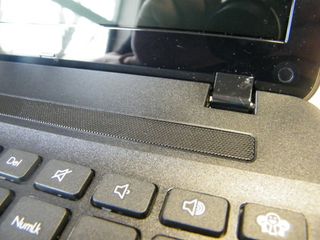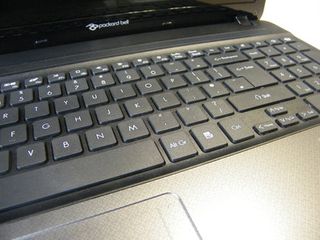Why you can trust TechRadar
Performance
The low-end EasyNote TS is isn't a rip-roaring games machine however you spin it. There's no chance of it trumping a Core i7 gaming laptop, such as the Dell XPS 15.
It's not quite an all-powerful media box either; it does the important bits, but lacks a Blu-ray drive or the 3D gimmmick of a Sony Vaio F, and its speakers, mounted above the keyboard, are a little bit weedy. But it is the most reasonably specced £500 laptop you'll find.

Let's start with the keyboard, for that's the real obvious draw when looking at the EasyNote TS open. The chiclet design is actually very effective, with little travel on the keys and a good amount of space between them.
It's not quite as consistent as the keys on the 15-inch MacBook Pro; certain areas feel a little spongier than Apple's brilliantly designed keyboard, but we can't fault it for speed or accuracy. Whether you feel you really need a number pad is a matter of taste.

The screen is sharp and vibrant, but it suffers from the common flaw of low-price panels; a general inconsistency of brightness and an optimal viewing angle that's actually shorter than the panel itself. There's no good spot; either the top of the screen is washed out, or the bottom is.
This is a shame, because Intel's HD Graphics 3000 system actually does a strong job at pushing pixels around, even if it's not quite up the the same level as the highest end of discrete GeForce or Radeon chipsets.
It's in the same silicon package as the Sandy Bridge Core i5-2410 processor, and this clearly has its advantages; performance in 3D games is pretty decent, beyond what we'd expect from internal graphics, although you'll need to keep the resolution low in newer games.
Basically this is a slickly presented machine that performs at its level, but feels a rung higher. It's not Packard Bell that's made the big muscle advancements, it's Intel; its selection of silicon steroids are really doing the trick.
The Sandy Bridge processors are a vein-popping leap ahead of everything that went before, and this particular chip runs cool, fast, and the battery lasts an impressive length of time for such a large notebook.
Benchmarks
3DMark 03 1024 x 768: 10,669
3DMark 06 1280 x 768: 3,070
Battery life: 4hrs 48m
Current page: Packard Bell EasyNote TS: Performance
Prev Page Packard Bell EasyNote TS: Specifications Next Page Packard Bell EasyNote TS: Verdict
